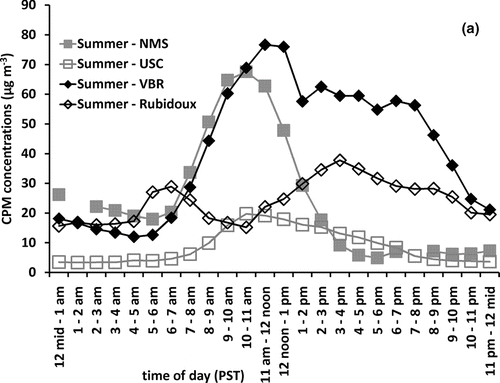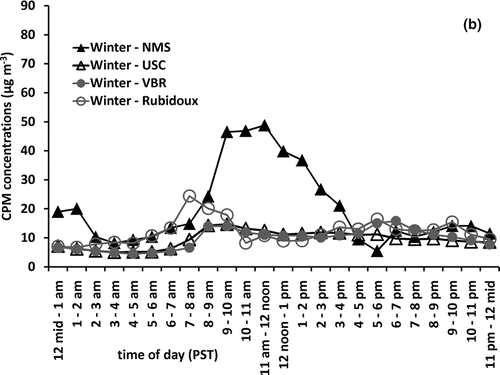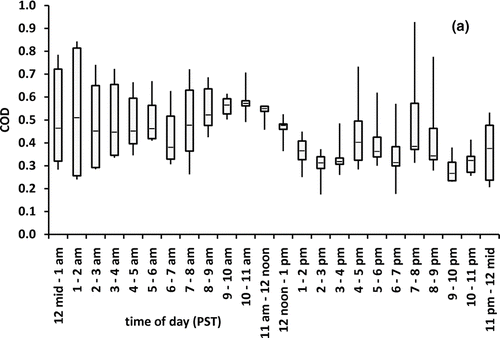Abstract
Continuous coarse particulate matter (CPM, PM 10−2.5 ) concentrations were measured hourly at three different sites in the Los Angeles area from April 2008 through May 2009 as part of a larger study of the characteristics and toxicology of CPM. Mean hourly concentrations calculated seasonally ranged from less than 5 μg m –3 to near 70 μg m –3 at the three sites depending upon the CPM source variability and prevailing meteorology. Different diurnal concentration profiles were observed at each site. Correlation analysis indicates that CPM concentrations can generally be explained by wind-induced road dust re-suspension, particularly in drier seasons. CPM concentrations between the sites were not appreciably correlated and metrics used to assess variability between the sites—the coefficients of divergence—indicated that CPM concentrations were heterogeneous. The relative CPM contribution to observed PM 10 concentrations varied by season and between sites. Additional concurrent CPM data available within a few km of the three sites indicate that intra-community variability can be on the same order as that observed for inter-community variability, although a similar analysis using PM 10 data yielded reduced heterogeneity. The results indicate that accurate exposure assessment to CPM in the Los Angeles area requires measurements of CPM concentrations at different sites with higher temporal resolution than a single daily mean value.
INTRODUCTION
Elevated ambient particulate matter concentrations are associated with adverse human health outcomes, including increased short-term cardiovascular mortality which is estimated to result annually in 40,000–60,000 premature deaths in the United States (US EPA, 2008). While most recent research has focused on the role of ultrafine particles (ca. < 0.1–0.2 μ m in diameter), there is sufficient evidence that coarse particulate matter (CPM, the difference between PM10 (particulate matter less than 10 μ m in diameter) and PM2.5 (particulate matter less than 2.5 μ m in diameter) or PM10-2.5) also is responsible for significant adverse effects (CitationPekkanen et al. 1997; CitationLi et al. 2003; Oberdörster et al. 2001; Xia et al. 2004; CitationMonn and Becker 1999; CitationBecker et al. 1996; CitationHornberg et al. 1998; CitationBecker et al. 2005; CitationVilleneuve et al. 2003; CitationKleinman et al. 2003; CitationOstro et al. 1999; CitationLipsett et al. 2006; CitationGraff et al. 2009). These observations suggest that the ambient CPM fraction should be a specific focus of research aimed at understanding the relationship between ambient particulate matter and public health.
In general, the CPM fraction in rural areas tends to be relatively lower (< 1 to 5–10 μ g/m3) than in suburban, urban, near-roadway, and industrial locations where concentrations are higher (ca. 5–10 to 40–50 μ g/m3, although most reported concentrations appear to be on the order of 20–25 μ g/m3 or less) (CitationQuerol et al. 2008; CitationYin and Harrison 2008; CitationWilliams et al. 2003; CitationPuustinen et al. 2007; CitationHouthuijs et al. 2001; CitationBrook et al. 1997, among others). Very high CPM concentrations exceeding several hundred μ g/m3 have been reported and have been primarily associated with dust storms (CitationClaiborn et al. 2000; CitationBirmili et al. 2008). In urban areas, traffic volume (e.g., vehicle speed, road/tire and brake material emissions) and distance to the street as well as meteorological parameters influence CPM concentrations (CitationLianou et al. 2007; CitationAlmeida et al. 2006; CitationBourotte et al. 2005, among others). In addition to these sources and industrial emissions, CPM may have a strong primary biological component from pollens and other organic detritus (CitationEdgerton et al. 2009) and a significant sea-salt component in coastal areas (Almeida et al. 2005; CitationArhami et al. 2009). A review of CPM concentrations using regulatory data in California for 1988–1998 indicated that highest CPM concentrations were observed in the summer and early fall when dry conditions, intense mixing in the boundary layer and consistent wind patterns promote re-suspension of significant amounts of soil dust/mineral matter (CitationMotabelli et al. 2003). Sampling campaigns conducted in Los Angeles area reported that the CPM fraction composed largely of nitrate and other crustal elements (CitationSardar et al. 2005) and also sea-salt (CitationArhami et al. 2009). However, other than few studies reporting continuous hourly or sub-hourly observations (e.g., CitationClaiborn et al. 2000; CitationGeller et al. 2004; CitationHarrison et al. 2001; CitationQuerol et al. 2008), much of the reported data are 24 h daily averages based upon limited time periods. Of course daily averages obscure diurnal variability and tend to smooth out the variability in reported CPM concentrations.
In order to further improve our understanding of the linkage between CPM concentrations and adverse health impacts, a field study utilizing multiple fixed sites was undertaken in the Los Angeles area to measure relevant properties of CPM including mass concentration, chemical composition and toxicological properties. The goal of this research is to lay the basis for the development of cost-effective strategies to protect the public from toxic sources of CPM and should indicate whether control strategies focused on a sub-set of sources only are desirable. Here we present the first results from the study: one complete year of simultaneous, continuous hourly CPM mass concentrations observed at three locations subject to distinctly different combinations of CPM sources in the Los Angeles air basin. This is a unique data set and—in combination with other facets of the study still underway—represents an invaluable resource for ongoing and planned efforts studying the relationship between CPM and human health in Los Angeles. In a companion paper, we report time-integrated CPM concentrations collected over the same time period at additional sites (CitationPakbin et al. 2010).
EXPERIMENTAL METHODS
Sites
Three sampling sites located near downtown Los Angeles, in Mira Loma (inland, near Riverside, designated “VBR”) and Lancaster were selected for this study (). Continuous hourly observations of CPM started in April 2008 and continued until May 2009, representing at least a complete year of data collection. With the exception of June and August 2008 at the downtown Los Angeles site and varying April 2008 start dates, data recovery exceeded 80% for each month at all sites (the summer (June/July/August) seasonal averages for the downtown Los Angeles site represent approximately 55% of the available time period, see discussion below). The downtown Los Angeles site is located on the campus of the University of Southern California at the Particle Instrumentation Unit (USC). This USC site is the primary field sampling location of the Southern California Particle Center and Supersite and observations made at this site have been widely reported (e.g., CitationSardar et al. 2005; CitationGeller et al. 2004, among others). The USC site is considered to be an urban background site, although it is located approximately 130 m to the NE of the I-110 freeway and observations indicate it is clearly impacted by motor vehicle emissions (e.g., CitationMoore et al. 2007, among others). The Mira Loma site (Mira Loma-Van Buren or VBR) is located at an existing South Coast Air Quality Management District (SCAQMD) site immediately adjacent to an elementary school and within 100 m of busy arterial roadways. If the USC site is located in an upwind, urban “source” site for CPM, the Mira Loma site is an inland, more rural “receptor” site for CPM and other pollutants. The Lancaster site (LAN) is located at an Antelope Valley Air Quality Management District (AVAQMD) site approximately 110 km to the NW of downtown Los Angeles and separated by the San Gabriel Mountains from the coast. It is a more rural location, highly influenced by the surrounding desert, although the monitoring site itself is adjacent to several arterial roadways, rail, and within ca. 2 km of the CA-14 highway. summarizes relevant information about each site, including sampling area, designation code, description, geographic coordinates, inlet elevation and data recovery.
FIG. 1 Geographic location of the monitoring sites in Los Angeles and Riverside County with select roadway features shown (to scale).

TABLE 1 Site information including sampling area, the designation code, description, geographic co-ordinates, inlet elevation, and data recovery
Equipment
Three Continuous Coarse Particulate Matter (CCPM) monitors (CitationMisra et al. 2001) were deployed at each of the three sites and operated continuously. The Coarse Particulate Matter monitors use a single virtual impactor upstream of a standard tapered element oscillating microbalance (TEOM model 1400a, Thermo Electron, Waltham, MA). The upstream impactor concentrates the CPM fraction measured by the downstream TEOM by an approximate factor of 25. The CCPM is now commercially available from Thermo Electron (TEOM model 1405-D). The CCPM can provide reliable CPM mass concentrations continuously at intervals as short as 5–10 min. For this study, observations were recorded every 30 min. Prior to the start of the study, two TEOMs were returned for factory recalibration. Following recalibration, side-by-side operation of these two TEOMs both before and after the study indicated consistent agreement within approximately 20% (R2 = 0.71; slope = 1.17; Figure S1 in supplemental information). The third TEOM also performed consistently compared to the mean of other two TEOMs during side-by-side operation (R2 = 0.69; slope = 1.55; Figure S2 in supplemental information). The slopes of the regression equations were used to adjust the data obtained from individual TEOMs prior to processing of the raw results. At each location, the CCPM was installed in a temperature-controlled environment. Regular weekly maintenance visits were performed where the flow rates were checked, the collected data downloaded and the TEOM internal filter changed.
Following data retrieval, the raw CCPM data were reviewed for erroneous data points (e.g., zero ambient CPM concentrations, excessive noise) and the hourly geometric mean CPM concentrations for the screened data calculated. Where available, co-located regulatory PM10 and PM2.5 mass concentration data were obtained to assist in the evaluation of potentially inconsistent CCPM data points. The hourly data from every day was combined to report monthly and seasonal averages for the study. All data are reported in Pacific Standard Time (PST).
Additional Data
Continuous hourly PM mass concentration, gas-phase concentration and meteorological data from the previously described SCAQMD and AVAQMD sites and three additional SCAQMD monitoring locations near the CCPM monitoring sites were also obtained from the California Air Resources Board in order to assist in the interpretation of the CPM concentrations reported herein. The USC site is located ca. 2 km to the SW of the downtown Los Angeles SCAQMD monitoring location (North Main Street (NMS); ) and the Mira Loma location is ca. 2.6 km to the ESE and 7 km to the W of the Mira Loma–Bellgrade and Riverside-Rubidoux SCAQMD sites, respectively (Bellgrade and Rubidoux; ).
Data Analysis
In addition to Pearson correlation coefficients, the Coefficients of Divergence (COD) were calculated for the PM concentrations as a measure of the heterogeneity between sites. The COD is defined as:
RESULTS AND DISCUSSION
Prior to presenting the ambient CPM results, a brief characterization of the meteorology of the study sites during the sampling period is in order. Total precipitation (measured at the Los Angeles International Airport) was approximately 8.1 in (20.6 cm) which is ca. 60–70% of “normal.” Virtually all of the precipitation occurred as a result of relatively brief, but often intense, winter storms as fronts crossed the Los Angeles air basin during November 2008–February 2009. Precipitation data were not readily available at all three of the monitoring sites and contemporaneous observations indicated that the time period during a storm that precipitation fell was not the same at each of the three sites. Given the very few number of days affected over the year-long study, sampling days where rain was observed at USC were removed prior to processing (we note, however, that CPM concentrations during precipitation periods rapidly fell predictably to zero/near-zero levels, with time series similar to that reported by Geller et al. 2004).
shows select meteorological parameters for the three principal study sites organized by time-of-day and season (Spring (March–May), Summer (June–August), Fall (September–November), and Winter (December–February)). Meteorological conditions at the USC site have been previously reported (e.g., CitationSardar et al. 2005; CitationMoore et al. 2007, among others) and are generally stable throughout the year with the predominant wind direction in the afternoon from the SW (please note that a large building to the N of the USC site may interfere with observations of the NE overnight return flow observed nearby at NMS). Overnight wind speed tends to be calm—particularly in the fall and winter—and peak mean wind speeds on the order of a few meters per second are observed in the afternoon. Temperatures are 10–12°C lower overnight with relative humidities as high as ca. 80% observed. In contrast, meteorological observations at both VBR and LAN exhibit considerably more variability although some similar patterns—higher wind speeds during the day, and lower temperatures and higher relative humidities (RHs) at night—are observed. In particular at the LAN site, strong W winds can be observed during any period of the day virtually independent of the season. Minimum daytime RH at Lancaster was routinely less than 20–30%, with the exception of the winter (40%) while at the other two sites, 40% was the year-round minimum. We highlight these results to indicate that while many of the meteorological patterns and factors are similar between the Mira Loma (VBR) and USC sites (e.g., RH range), the Lancaster site is markedly different exhibiting larger extremes in observed mean temperature than the other sites, consistent with more desert-like conditions. Occasionally the strong, dry (RH < 10%), hot off-shore wind conditions known locally as Santa Ana winds impact the Los Angeles area. Santa Anas tend to occur in the fall, but can arise throughout the year. The Santa Anas affect the three sites differently—at the USC site virtually no change in wind speed and direction are observed while the Mira Loma and Lancaster sites are strongly impacted. In Mira Loma, winds are higher during daytime and are associated with a persistent NE/N direction. Santa Anas at Lancaster may also have very strong NE/ENE persistent winds but also, occasionally are associated with winds of high velocity from the WNW and E.
TABLE 2 Seasonal meteorological parameters by site and time of day (all times in PST)
Review of the diurnal profile of the monthly CPM concentrations indicated that using a seasonal description of the data was appropriate as month-to-month variability was limited. (CitationPakbin et al. 2010 include monthly data showing daily mean concentrations.) shows the hourly diurnal profile of CPM and additional parameters, i.e., temperature, relative humidity, wind speed, and gas and particle-phase concentrations for the three sites. For clarity, only particle-phase concentration data are shown in most of the panels of as the patterns for the other parameters do not appreciably change from season-to-season (although the magnitudes can as shown in ).
FIG. 2 Seasonal averages of coarse particulate matter concentrations (PM10 − 2.5) and additional measured parameters (PM10 or PM2.5, relative humidity (RH), temperature (T), CO, and wind speed) at the (a) Mira Loma, (b) Lancaster, and (c) USC sites.
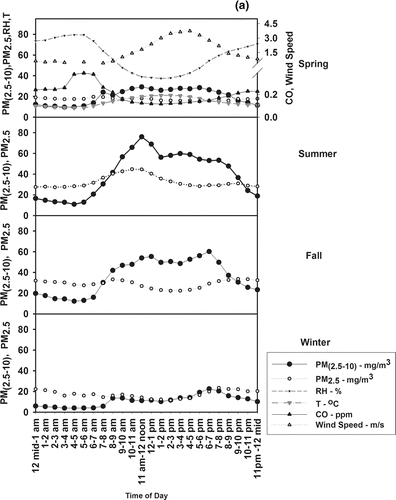

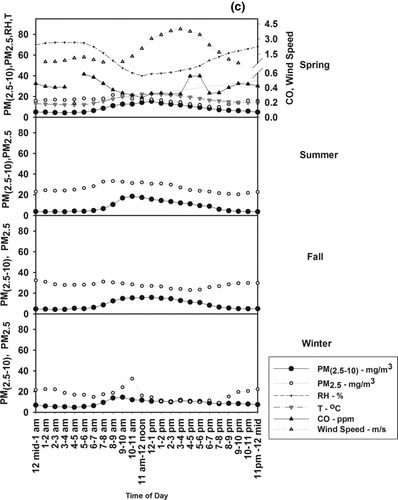
In Mira Loma (), there is a distinct diurnal pattern in the hourly CPM data. During the spring, low overnight concentrations (ca. 10 μ g m–3) rise rapidly to ca. 20 μ g m–3 where they nominally remain until starting to fall off during the evening commute and then decaying rapidly to overnight concentrations by 10 pm (this same rapid decay to overnight concentrations following the evening commute is observed across all seasons in Mira Loma). The summer CPM concentration is markedly different although it shows similarly relatively low (ca. 15–20 μ g m–3) overnight concentrations. Concentrations start rising with the morning commute and peak at values exceeding 70 μ g m–3 by 10 am before falling to ca. 50 μ g m–3 for the rest of the day through the evening commute. During the fall, the peak in CPM concentrations in Mira Loma is slightly lower (60 μ g m–3) during the afternoon, while the winter CPM concentration profile is more similar to the spring profile. The peak in the CPM concentrations at the Mira Loma site occurs when strong westerly winds tend to be observed during the summer and fall, yet these same winds occur during the spring without a similar increase in CPM concentrations. The relatively elevated CPM concentration particularly in summer might be partly attributed to a construction activity occurring for a couple of weeks in summer and fall season at an approximate distance of 200 m to the NW of the Mira Loma. CPM concentrations are inversely correlated with relative humidity and positively correlated with temperature and wind speed () for all seasons except for winter. The correlations appear strongest in summer (driest season) compared to the spring and fall. The value of these correlation coefficients indicates wind-induced road dust re-suspension as a major source of CPM at Mira Loma. PM2.5 concentrations at Mira Loma are higher overnight (20–30 μ g m–3) and tend to exhibit both morning and late evening relative peaks in concentration. PM 2.5 diurnal variation is also more pronounced during the summer and fall. CPM concentrations tend to be lower than PM 2.5 concentrations during the night and early morning hours but CPM concentrations are shown to dominate here during the day, particularly in the summer and fall. In Lancaster (), considerably less seasonal variability is observed than in Mira Loma. In contrast, however, to Mira Loma, two distinct CPM peaks—in the early morning and evening, coinciding with commute periods—are observed. While the diurnal pattern is persistent, CPM concentrations are lowest in the winter, as seen in Mira Loma, with peak values on the order of 10 μ g m–3. In the immediate vicinity of the Lancaster site to the E and W are two multi-laned arterial roadways with occasionally heavy commute traffic (C Anderson (AVAQMD), personal communication, 2008). The morning peak is associated with rising CO concentrations (). CPM concentrations are again lowest overnight but ambient values are lower in Lancaster (ca. 5–15 μ g m–3). In the middle of the day, CPM concentrations dip and are up to ca. 5 μ g m–3 lower than the morning or evening commute-associated peak (20–25 μ g m–3). Correlations between additional parameters and CPM concentrations is generally poor except for the moderate correlations with relative humidity, temperature and wind speed, particularly in spring, summer, and fall (drier seasons; ). PM10 concentrations are available in Lancaster and are highly similar in diurnal pattern and concentration level to the CPM concentrations. Again, in contrast to Mira Loma, PM10 concentrations in Lancaster are almost entirely composed of CPM and, while not measured, PM2.5 concentrations appear to be negligible. Despite the occasionally strong westerly winds, the Antelope Valley appears to not be subject to the PM2.5 concentrations routinely observed elsewhere in the Los Angeles area. Relatively high CPM concentrations, though, appear to be associated with motor vehicle traffic during the commute periods suggesting re-suspension of road dust by moving vehicles can be significant.
TABLE 3 Pearson correlation coefficients (R) for the regression analysis of PM 10−2.5 and PM2.5 (PM10 at Lancaster) with other measured parameters
The diurnal profiles of CPM observations at the USC site () are somewhat intermediate to the observations at both the Mira Loma and Lancaster sites. CPM concentrations are similarly low overnight (ca. 10 μ g m–3) and rise to a mid-morning peak following the morning commute. However, a second evening peak or concentration plateau is also observed, particularly in the summer and winter. The range of peak daytime concentrations is muted compared to the other two sites and is 20–25 μ g m–3 throughout the year. As in Mira Loma, CPM at the USC site is fairly correlated with temperature, relative humidity and wind speed, particularly in drier seasons, with the highest correlation coefficient (r) values in summer. Available PM2.5 concentration data from the nearby NMS site suggest that PM2.5 makes by far the larger contribution to PM10 concentrations than CPM, although CPM can be an important contributor during the middle of the day. Overnight PM2.5 concentrations nearby are 2–5 times larger than the CPM concentrations measured at the USC site. The USC PM concentrations—consistent with its downtown Los Angeles location—are dominated by the PM2.5 fraction. The VBR and USC CPM results are consistent with the general urban findings reported in the earlier studies (CitationMotabelli et al. 2003; CitationLianou et al. 2007, among others). The LAN results are within the range of the non-urban site data reported by Motabelli and colleagues, although the PM2.5 contribution to PM10 at LAN appears to be lower than observed elsewhere.
The results shown in show that the “source,” “receptor,” and “desert” CPM concentrations vary markedly between sites in their diurnal patterns, seasonal variations, absolute concentrations and relationship to additional parameters including PM2.5 and PM10 concentrations. While motor vehicles and wind speed are likely to impact CPM concentrations at each site, local factors—including the volume of traffic and relative humidity—provide varying contributions to each site. In the desert site, CPM concentrations are virtually identical to PM10 concentrations while in Mira Loma and downtown Los Angeles, PM2.5 makes a more significant contribution to total PM10 concentrations.
Correlation between the CPM concentrations at the three sites is generally poor (). Median r values vary from ca. 0.1 to 0.4 and there does not appear to be a particular pattern in the monthly or seasonal data so only the overall results for the year are shown. Negative as well as positive correlation values are observed during all hours and there is considerable variability at all times of the day. The moderately high COD values (median COD > 0.35; ) indicate overall heterogeneity in inter-community CPM concentrations. CODs are relatively lower (0.4 or less) in the early morning and during middle of the day periods, and higher during the morning commute and early evening hours. These high values are in contrast to most of the COD values previously reported for PM2.5 concentrations in the Los Angeles area (CitationPinto et al. 2004) and CPM in Long Beach (CitationKrudysz et al. 2008), although similar to some European observations (CitationLianou et al. 2007) for CPM concentrations. It is probable that the higher values results from doing the analysis using continuous—as opposed to 24-h mean—values consistent with the COD results reported by CitationPakbin et al. (2010). This emphasizes the benefit of collecting continuous data to provide improved temporal resolution in the CPM mass concentrations. The use of continuous data instead of daily 24 h mean concentrations may also contribute to the lack of correlation between the regional sites, although previous work (CitationWilson et al. 2005 and references therein) show somewhat worse correlation for CPM concentrations compared to PM10 and PM2.5 observed in other urban locations. This result suggests that improved exposure assessments for CPM may be city specific, and should consider the daily temporal variability in mass concentrations for accuracy.
FIG. 3 Continuous CPM measurements. (a) coefficients of divergence for the entire study, (b) corresponding r (Pearson correlation coefficient) for the entire study. Box/whisker plots show the minimum, 1st quartile, median, 3rd quartile and maximum values observed.
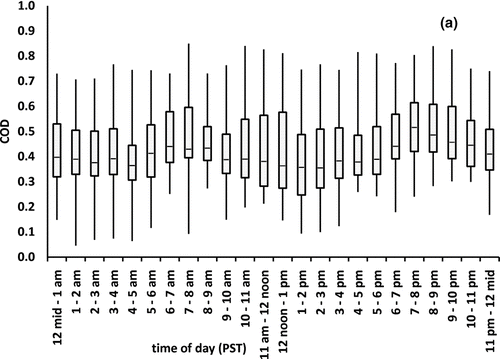

While limited, data are also available to assess the near-field variability in CPM and PM10 concentrations. The summer and winter CPM concentrations at the paired Mira Loma/Rubidoux (separated by 7 km) and USC/NMS (separated by 2 km) sites are shown in . During the summer, the Rubidoux CPM concentrations exhibit a morning and afternoon peak (as also observed in Lancaster), while the NMS site has a rapid early morning rise to a single peak concentrations on the order of 60 μ g m–3 which does not persist into the early afternoon. Similar behavior is observed in both the Rubidoux and NMS CPM concentrations during the winter, although peak concentrations are reduced by ca. 15–20%. Substantially different CPM concentrations are observed despite the limited spatial scale. The CODs calculated for these two site pairs and seasons indicate higher heterogeneity () than that observed for the Lancaster-USC-Mira Loma site pairs separated by greater distances (). Median values near 0.6 are observed during the middle of the day and somewhat reduced COD values (< 0.4) tend to be observed only in the early and late evenings. The summer COD values, particularly in the morning, tend to be higher due to the greater difference in observed CPM concentrations between the site pairs than compared to the winter. Detailed continuous CPM chemical composition data at hourly resolution are not available to help interpret these observations. However, these results suggest that variability in sources on sub-km scales can produce considerably different ambient concentrations of CPM, leading to highly variable population exposures to these particles. These observations suggest that—similar to previous findings on ultrafine particulate matter concentrations (CitationMoore et al. 2009; Krudysz et al. 2009)—it is insufficient to use a single observation point in a community to predict exposures to CPM concentrations. The proximity to individual sources, the temporal profile in source strengths and prevailing meteorology must all be considered.
In the Mira Loma/Riverside area, PM10 concentrations can be compared seasonally across the Rubidoux, Mira Loma (VBR), and Bellgrade sites. The PM10 concentration reported for VBR is the sum of the CPM concentrations reported here and the PM2.5 concentrations reported by SCAQMD at the same site. At the other two sites, the PM10 concentrations were directly measured. Again, the spring/summer and fall/winter seasons yield similar results and only summer and winter are shown here (). The Bellgrade and Rubidoux sites in the summer have considerably lower peak concentrations than the observations at VBR. Very little diurnal variability is observed at Bellgrade and all three sites have very similar early morning PM10 concentrations (ca. 40 μ g m–3). In the winter, virtually identical diurnal patterns and concentrations are observed at all 3 sites although the timing of the morning peak is somewhat later at VBR (). Not surprisingly, somewhat higher COD values are observed for the PM10 concentrations between the 3 sites during the day in the summer. The early morning and late evening summer COD values as well as virtually all of the winter COD values are homogeneous or near homogeneous across the 3 sites (). In the early morning—when our CPM observations suggest PM2.5 is an important contributor to the observed PM10 concentrations in this area (), COD values are relatively low. Large differences in CPM concentrations over limited distances, however, given particle size-dependent atmospheric lifetimes, can produce sufficiently different PM10 concentrations to result in heterogeneous COD values as may be expected (CitationWilson et al. 2005). Our observations suggest that it may be inappropriate to calculate CPM concentrations using PM10 and PM2.5 concentrations obtained at different sites—even those separated by less than a few km. Accurate CPM concentration data, and thus, accurate exposure assessments to CPM, require observations made at the same location.
FIG. 6 Continuous PM10 measurements at adjacent sites in Riverside/Mira Loma shown by season; (a) summer and (b) winter.
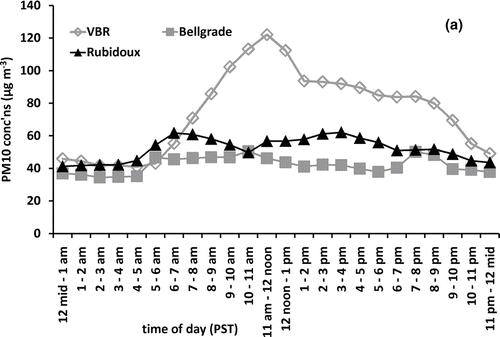
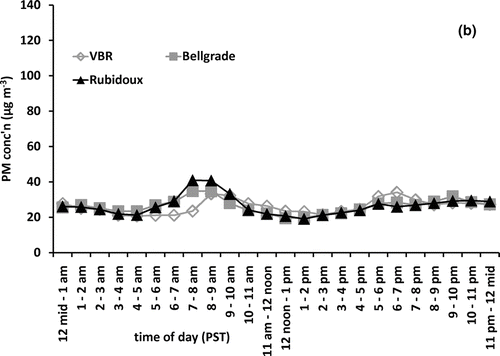
FIG. 7 Continuous PM10 measurements at adjacent Riverside/Mira Loma sites. Coefficients of Divergence calculated by season; (a) summer and (b) winter.
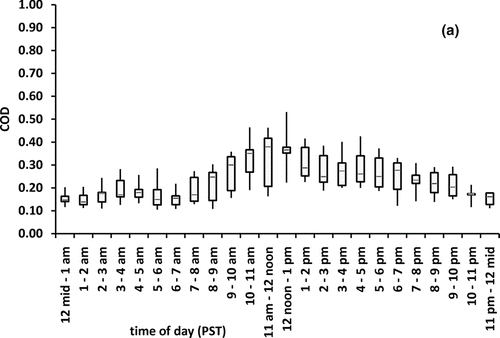
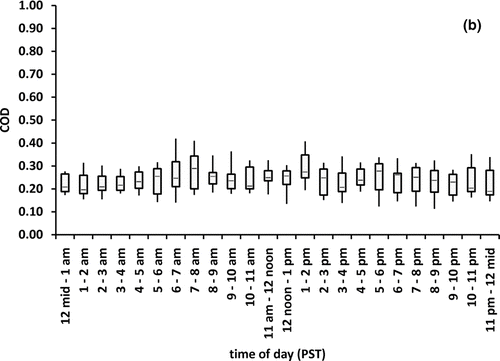
It is important to acknowledge that the results presented here focus on seasonal values which provide insight to chronic exposures, but which overlook the considerable day-to-day variability in hourly CPM concentrations observed at the Lancaster, VBR, and USC sites due to variability in sources and meteorology. Standard deviations calculated monthly using the hourly CPM data are approximately on the order of geometric mean concentrations reported (not shown). As described above, acute exposures to elevated CPM concentrations are also a cause for concern and have been associated with dust storms. In the Los Angeles area, Santa Ana wind conditions are associated with extremely elevated CPM concentrations at some of the sites (the peak CPM mass concentrations at the USC site are relatively unaffected by the presence of these winds). In Lancaster—near the desert—and at VBR where strong down slope winds result in the considerable suspension of dust, peak hourly CPM concentrations as high as 600 μ g m–3 () are observed and CPM concentrations remain elevated as long as the wind speed does. These values are consistent with observations during dust storms observed elsewhere (e.g., CitationClaiborn et al. 2000; CitationBirmili et al. 2008) when allowing for differences in averaging times. In instances like these, the seasonal approach used here may not fully capture the true variability associated with extreme events such as these. Santa Ana wind conditions are routinely observed for limited time periods in the Los Angeles area, particularly in the fall and winter.
CONCLUSIONS
We conducted a year-long measurement campaign at 3 sites in the Los Angeles area subject to different CPM sources and meteorology. Considerable differences in concentration between the 3 sites were observed as a function of season and time of day. Motor vehicle traffic and wind induced road dust re-suspension appear to be generally responsible—even at the most remote site—for the observed CPM concentrations. Peak monthly mean CPM concentrations as high as 60 μ g m–3 were observed, and the more remote desert site had the lowest observed concentrations. COD values calculated across these widely separated 3 sites were heterogeneous. Additional available CPM mass concentration data available for pairs of sites separated by less than 7 km yielded variability in concentration data and COD values on the same order as observed for the widely separated sites. The variability in PM10 concentrations across pairs of sites separated by less than 10 km, yielded more homogeneous results. These results indicate that improved exposure assessments for CPM must take into consideration the sharp gradients possible in CPM sources and sinks on relatively small spatial scales.
uast_a_475473_sup_13610588.zip
Download Zip (80.2 KB)Acknowledgments
[Supplementary materials are available for this article. Go to the publisher's online edition of Aerosol Science and Technology to view the free supplementary files.]
This research was supported by the US Environmental Protection Agency under STAR grant #RD833743 and MESA Air grant #RD831697. The authors gratefully acknowledge the assistance of the Antelope Valley Air Quality Management District, the South Coast Air Quality Management District, CJ Fisk (for meteorological data and advice), and the USC Aerosol Laboratory group members who participated in this project (A. Polidori, J. Boyer, M. Arhami, Z. Ning, S. Lu, R. Jain, N. Hudda, P. Pakbin, K.L. Cheung, W. Kam, A. Chaudhary).
Notes
*Height relative to the ground.
REFERENCES
- Almeida , S. M. , Pio , C. A. , Freitas , M. C. , Reis , M. A. and Trancoso , M. A. 2006 . Source Apportionment of Atmospheric Urban Aerosol Based on weekdays/weekend Variability: Evaluation of Road Re-Suspended Dust Contribution . Atmos. Environ. , 40 : 2058 – 2067 .
- Arhami , M. , Sillanpaa , M. , Hu , S. H. , Olson , M. R. , Schauer , J. J. and Sioutas , C. 2009 . Size-Segregated Inorganic and Organic Components of PM in the Communities of the Los Angeles Harbor . Aerosol Sci. Technol. , 43 : 145 – 160 .
- Becker , S. , Soukup , J. M. , Gilmour , M. I. and Devlin , R. B. 1996 . Stimulation of Human and Rat Alveolar Macrophages by Urban Air Particulates: Effects on Oxidant Radical Generation and Cytokine Production . Toxicol. Appl. Pharmacol. , 141 : 637 – 648 .
- Becker , S. , Dailey , L. A. , Soukup , J. M. , Grambow , S. C. , Devlin , R. B. and Huang , Y. C. T. 2005 . Seasonal Variations in Air Pollution Particle-induced Inflammatory Mediator Release and Oxidative Stress . Environ. Health Perspect. , 113 : 1032 – 1038 .
- Birmili , W. , Schepanski , K. , Ansmann , A. , Spindler , G. , Tegen , I. , Wehner , B. , Nowak , A. , Reimer , E. , Mattis , I. , Muller , K. , Bruggemann , E. , Gnauk , T. , Herrmann , H. , Wiedensohler , A. , Althausen , D. , Schladitz , A. , Tuch , T. and Loschau , G. 2008 . A Case of Extreme Particulate Matter Concentrations Over Central Europe Caused by Dust Emitted Over the Southern Ukraine . Atmos. Chem. Phys. , 8 : 997 – 1016 .
- Bourotte , C. , Forti , M.-C. , Taniguchi , S. , Caruso Bicego , M. and Lotufo , P. A. 2005 . A Wintertime Study of PAHs in Fine and Coarse Aerosols in Sao Paulo City, Brazil . Atmos. Environ. , 39 : 3799 – 3811 .
- Brook , J. R. , Dann , T. F. and Burnett , R. T. 1997 . The Relationship Among TSP, PM10, PM2.5 and Inorganic Constituents of Atmospheric Particulate Matter at Multiple Canadian Locations . J. Air and Waste Manag. Assoc. , 47 : 2 – 19 .
- Claiborn , C. S. , Finn , D. , Larson , T. V. and Koenig , J. Q. 2000 . Windblown Dust Contributes to High PM2.5 Concentrations . J. Air and Waste Manag. Assoc. , 50 : 1440 – 1445 .
- Edgerton , E. S. , Casuccio , G. S. , Saylor , R. D. , Lersch , T. L. , Hartsell , B. E. , Jansen , J. J. and Hansen , D. A. 2009 . Measurements of OC and EC in Coarse Particulate Matter in the Southeastern United States . J. Air and Waste Manag. Assoc. , 59 : 78 – 90 . doi: 10.3155/1047-3289.59.1.78
- Geller , M. D. , Fine , P. M. and Sioutas , C. 2004 . The Relationship between Real-Time and Time-Integrated Coarse (2.5–10 μ m), Intermodal (1–2.5 μ m), and Fine (< 2.5 μ m) Particulate Matter in the Los Angeles Basin . J. Air and Waste Manag. Assoc. , 54 : 1029 – 1039 .
- Graff , D. W. , Cascio , W. E. , Rappold , A. , Zhou , H. , Huang , Y.-C. T. and Devlin , R. E. 2009 . Exposure to Concentrated Coarse Air Pollution Particles Causes Mild Cardiopulmonary Effects in Healthy Young Adults . Environ. Health Perspect. , 117 : 1089 – 1094 .
- Harrison , R. M. , Yin , J. , Mark , D. , Stedman , J. , Appleby , R. S. , Booker , J. and Moorcroft , S. 2001 . Studies of the Coarse Particle (2.5–10 μ m) Component in UK Urban Atmospheres . Atmos. Environ. , 35 : 3667 – 3679 .
- Hornberg , C. , Maciuleviciute , L. , Seemayer , N. H. and Kainka , E. 1998 . Induction of Sister Chromatid Exchanges (SCE) in Human Tracheal Epithelial Cells by the Fractions PM-10 and PM-2.5 of Airborne Particulates . Toxicol. Lett. , 96–7 : 215 – 220 .
- Houthuijs , D. , Breugelmans , O. , Hoek , G. , Vaskovi , E. , Mihalikova , E. , Pastuszka , J. S. , Jirik , V. , Sachelarescu , S. , Lolova , D. , Meliefste , K. , Uzunova , E. , Marinescu , C. , Volf , J. , de Leeuw , F. , van de Wiel , H. , Fletcher , T. , Lebret , E. and Brunekreef , B. 2001 . PM10 and PM2.5 Concentrations in Central and Eastern Europe: Results from the Cesar Study . Atmos. Environ. , 35 : 2757 – 2771 .
- Kleinman , M. T. , Sioutas , C. , Chang , M. C. , Boere , A. J. F. and Cassee , F. R. 2003 . Ambient Fine and Coarse Particle Suppression of Alveolar Macrophage Functions . Toxicol. Lett. , 137 ( 3 ) : 151 – 158 .
- Krudysz , M. A. , Froines , J. F. , Fine , P. M. and Sioutas , C. 2008 . Intra-community Spatial Variation of Size-Fractionated PM Mass, OC, EC and Trace Elements in the Long Beach, CA Area . Atmos. Environ. , 42 : 5374 – 5389 .
- Li , N. , Sioutas , C. , Froines , J. R. , Cho , A. , Misra , C. and Nel , A. 2003 . Ultrafine Particulate Pollutants Induce Oxidative Stress and Mitochondrial Damage . Environ. Health Perspect. , 111 ( 4 ) : 455 – 460 .
- Lianou , M. , Chalbot , M.-C. , Kotroanou , A. , Kavouras , I. G. , Karakatsani , A. , Katsouyanni , K. , Puustinnen , A. , Hameri , K. , Vallius , M. , Pekkanen , J. , Meddings , C. , Harrison , R. M. , Thomas , S. , Ayres , J. G. , ten Brink , H. , Kos , G. , Meliefste , K. , de Hartog , J. J. and Hoek , G. 2007 . Dependence of Home Outdoor Particulate Mass and Number Concentrations on Residential and Traffic Features in Urban Areas . J Air and Waste Manag. Assoc. , 57 : 1507 – 1517 . doi: 10.3155/1047-3289.57.12.1507
- Lipsett , M. J. , Tsai , F. C. , Roger , L. , Woo , M. and Ostro , B. D. 2006 . Coarse Particles and Heart Rate Variability Among Older Adults with Coronary Artery Disease in the Coachella Valley, California . Environ. Health Perspect. , 114 ( 8 ) : 1215 – 1220 .
- Misra , C. , Geller , M. D. , Shah , P. , Sioutas , C. and Solomon , P. A. 2001 . Development and Evaluation of a Continuous Coarse (PM10-PM2.5) Particle Monitor . J Air and Waste Manag. Assoc. , 51 : 1309 – 1317 .
- Monn , C. 2001 . Exposure Assessment of Air Pollutants: A Review on Spatial Heterogeneity and Indoor/Outdoor/Personal Exposure to Suspended Particulate Matter, Nitrogen Dioxide and Ozone . Atmos. Environ. , 35 : 1 – 32 .
- Monn , C. and Becker , S. 1999 . Cytotoxicity and Induction of Proinflammatory Cytokines from Human Monocytes Exposed to Fine (PM2.5) and Coarse Particles (PM10−2.5) in Outdoor and Indoor Air . Toxicol. Appl. Pharmacol. , 155 ( 3 ) : 245 – 252 .
- Moore , K. F. , Ning , Z. , Ntziachristos , L. and Sioutas , C. 2007 . Daily Variation in Summer Urban Ultrafine Particle Properties—Physical Characterization and Volatility . Atmos. Environ. , 41 ( 38 ) : 8633 – 8646 .
- Moore , K. F. , Krudysz , M. , Pakbin , P. , Hudda , N. and Sioutas , C. 2009 . Intra-Community Variability in Ultrafine Particle Number Concentrations in the San Pedro Harbor Area (Los Angeles, California) . Aerosol Sci. Technol. , 43 : 587 – 603 .
- Motabelli , N. , Taylor , C. A. and Croes , B. E. 2003 . Particulate Matter in California: Part 2—Spatial, Temporal and Compositional Patterns of PM2.5, PM10 − 2.5, and PM10 . J Air and Waste Manag. Assoc. , 53 : 1517 – 1530 .
- Oberdorster , G. 2001 . Pulmonary Effects of Inhaled Ultrafine Particles . Intl. Arch. Occupat. Environ. Health , 74 ( 1 ) : 1 – 8 .
- Ostro , B. D. , Hurley , S. and Lipsett , M. J. 1999 . Air Pollution and Daily Mortality in the Coachella Valley, California: A Study of PM10 Dominated by Coarse Particles . Environ. Res. , 81 ( 3 ) : 231 – 238 .
- Pakbin , P. , Cheung , K. L. , Hudda , N. , Moore , K. F. and Sioutas , C. 2010 . Spatial and Temporal Variability in Coarse Particulate Matter (PM10 − 2.5) in the Los Angeles Area, manuscript in preparation for submittal to Aerosol . Sci. Technol. , 44 : 514 – 525 .
- Pekkanen , J. , Timonen , K. L. , Ruuskanen , J. , Reponen , A. and Mirme , A. 1997 . Effects of Ultrafine and Fine Particles in Urban Air on Peak Expiratory Flow Among Children with Asthmatic Symptoms . Environ. Res. , 74 ( 1 ) : 24 – 33 .
- Pinto , J. P. , Lefohn , A. S. and Shadwick , D. S. 2004 . Spatial Variability of PM2.5 in Urban Areas in the United States . J Air and Waste Manag. Assoc. , 54 : 440 – 449 .
- Puustinen , A. , Hameri , K. , Pekkanen , J. , Kulmala , M. , de Hartog , J. , Meliefste , K. , ten Brink , H. , Kos , G. , Katsouyanni , K. , Karakatsani , A. , Kotronarou , A. , Kavouras , I. , Meddings , C. , Thomas , S. , Harrison , R. , Ayres , J. G. , van der Zee , S. and Hoek , G. 2007 . Spatial Variation of Particle Number and Mass over Four European Cities . Atmos. Environ. , 41 : 6622 – 6636 .
- Querol , X. , Pey , J. , Minguillon , M.-C. , Perez , N. , Alastuey , A. , Viana , M. , Moreno , T. , Bernabe , R. M. , Blanco , S. , Cardenas , B. , Vega , E. , Sosa , G. , Escalona , S. , Ruiz , H. and Artinano , B. 2008 . PM Speciation and Sources in Mexico during the MILAGRO-2006 Campaign . Atmos. Chem. Phys. , 8 : 111 – 128 .
- Sardar , S. B. , Fine , P. M. and Sioutas , C. 2005 . Seasonal and Spatial Variability of the Size-Resolved Chemical Composition of Particulate Matter (PM10) in the Los Angeles, Basin . J. Geophys. Res.—Atmospheres , 110 : D07S08 doi:10.1029/2004JD004627
- US EPA . 2008 . Integrated Science Assessment for Particulate Matter , National Center for Environmental Assessment .
- Villeneuve , P. J. , Burnett , R. T. , Shi , Y. L. , Krewski , D. , Goldberg , M. S. , Hertzman , C. , Chen , Y. and Brook , J. 2003 . A time-series Study of Air Pollution, Socioeconomic Status, and Mortality in Vancouver, Canada . J. Exposure Anal. Environ. Epidemiol. , 13 ( 6 ) : 427 – 435 .
- Williams , R. , Suggs , J. , Rea , A. , Leovic , K. , Vette , A. , Croghan , C. , Shelon , L. , Rodes , C. , Thornburg , J. , Ejire , A. , Herbst , M. and Sanders , W. Jr. 2003 . The Research Triangle Park Particulate Matter Panel Study: PM Mass Concentration Relationships . Atmos. Environ. , 37 : 5349 – 5363 .
- Wilson , J. G. , Kingham , S. , Pearce , J. and Sturman , A. 2005 . A Review of Intraurban Variations in Particulate Air Pollution: Implications for Epidemiological Research . Atmos. Environ. , 39 : 6444 – 6462 .
- Yin , J. and Harrison , R. M. 2008 . Pragmatic Mass Closure Study for PM1.0, PM2.5 and PM10 at Roadside, Urban Background and Rural Sites . Atmos. Environ. , 42 : 980 – 988 .
